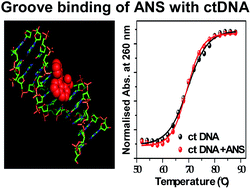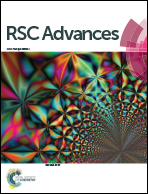Binding of an anionic fluorescent probe with calf thymus DNA and effect of salt on the probe–DNA binding: a spectroscopic and molecular docking investigation†
Abstract
Binding interaction of a biologically relevant anionic probe molecule, 8-anilino-1-naphthalene sulfonate (ANS) with calf-thymus deoxyribonucleic acid (ctDNA) has been investigated exploiting vivid spectroscopic techniques together with molecular docking study. Significant modifications in the absorption and emission profiles, the determined binding constant, micropolarity analysis, circular dichroism (CD) spectral study, comparative binding study with ethidium bromide (EtBr)—an intercalative binder, thermometric experiment relating to the helix melting of ctDNA and blind molecular docking simulation confirm the groove binding of ANS with ctDNA. Furthermore, a remarkable enhancement is observed in the fluorescence intensity as well as in the fluorescence lifetime of the DNA-bound probe with the addition of salts. Reduction in the electrostatic repulsion between the ANS and DNA at high salt concentration has been assigned responsible for this observation. Besides providing an insight into the probe–DNA interaction, the work implies that the binding interaction of a negatively charged probe with DNA can be enhanced considerably by the addition of salts.


 Please wait while we load your content...
Please wait while we load your content...